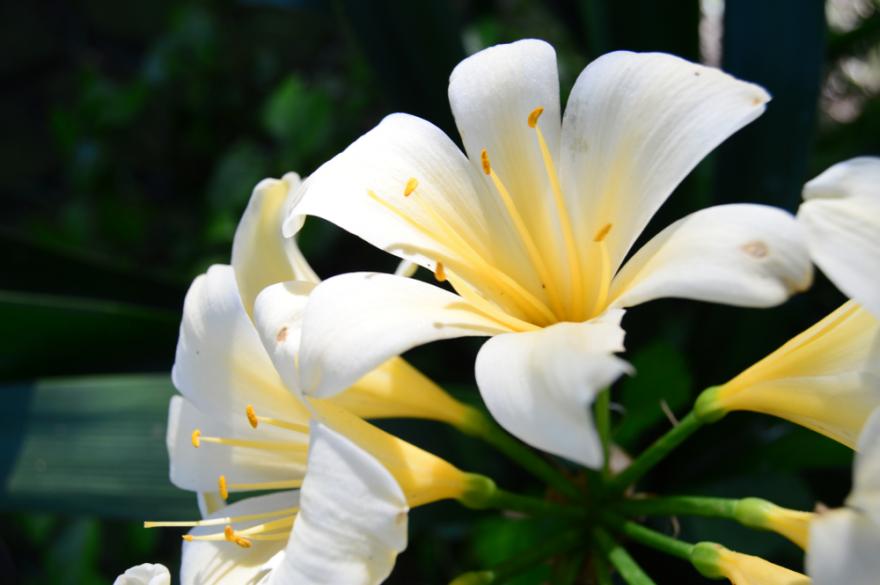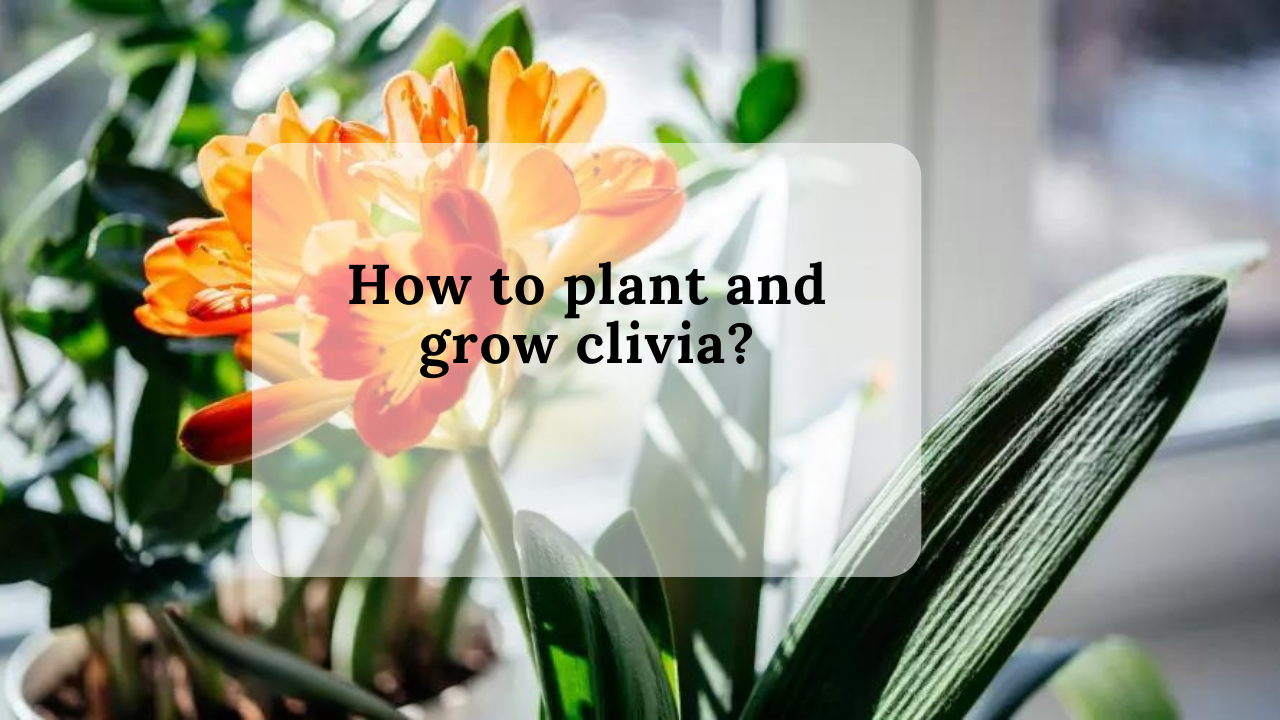Tips and tricks for making an exotic houseplant bloom
With its pretty foliage and colorful flowers, the clivia is an ideal plant to brighten up any room in the house!
How to plant and grow clivia?
The characteristics of the clivia
- Type : flower and flowering plant
- Height : 30 to 60 cm
- Flower colors : red, yellow, orange
- Soil type : humus, sandy
- Foliage : evergreen
- Vegetation : perennial
- Maintenance : frequent watering
- Sanitizer : no
- Diseases : cochineal
- Varieties : clivia caulescens, clivia gardenii, clivia miniata…
Origins and particularities of the clivia
The clivia is a flowering plant in the Amaryllidaceae family . Originally from South Africa, it offers evergreen foliage and can reach 60 cm in height. This not very hardy plant is best grown indoors (it is particularly suitable for growing in a veranda and greenhouse) and flowers at the end of winter for several weeks.
There are few species of clivias ; the clivia caulescens offers orange-red flowers while the clivia miniata citrina bears yellow flowers. The clivia gardenii, for its part, offers very pretty tubular flowers of orange-yellow color.
Visually, the clivia is a flowering plant which is characterized by:
- Its dark green, almost varnished foliage, whose large leaves grow in a fan shape.
- Its pretty colorful flowers which look like little bells.
- Its roots which, which is rare enough to be underlined, do not grow in the earth but on the surface!
Note : clivia is a plant whose roots, flowers, leaves and sap are toxic . Be careful where you place your potty in your home, especially if you have mischievous pets or children who get into everything!
Planting the clivia
As mentioned previously, clivia is best grown indoors and in pots .
The ideal is to find a pot that is not very wide (the plant does not like to have too much space) and has a hole at the bottom for good drainage.
In this pot, place equal parts of fibrous potting soil, sand and peat. The roots grow high and thus lift the soil, do not fill your pot. Pack, water and place your pot in the light but not directly in the sun or near a heat source.
If in winter the clivia needs a little coolness (around 10°) to flourish better the following year, it is important to offer it a temperature around 20° in summer.

Growing and caring for clivia
The clivia does not require much attention . Above all, it is imperative to place it in a place that meets its needs. Concerning watering, it must be regular in summer, while ensuring that the soil dries each time before watering again. Watering is reduced in autumn and is almost useless in winter.
After flowering and before the start of autumn, fertilize your plant twice a month. If it doesn’t flower, check that you’re providing it with enough light and space.
Every three years , it is advisable to change the pot because the roots of the plant take up a lot of space.
Good to know : As clivia is a toxic plant , do not hesitate to use gloves when handling it .
Clivia size
There is no need to prune it, just remove the dry flowers as you go.
Multiplication of the clivia
Division of tufts
- Age of the plant: Wait until the plant has reached a certain maturity. Generally, it is recommended to divide clivia clumps every 4 to 5 years.
- Choose the right time: Spring is often the best time to divide clivias. This is when the plant begins to show signs of active growth.
- Remove the plant from the pot: If your clivia is potted, carefully remove the plant from the pot by gently tilting the pot to the side while supporting the base of the plant.
- Separate suckers: Look for suckers that emerge from the base of the mother plant. Suckers are small shoots with roots. Use a clean, sharp knife to gently separate the suckers from the main plant.
- Prepare the new plants: Each sucker you separate should have its own roots. Plant each sucker in a suitable pot with a well-draining potting mix.
- Watering and care: Water new plants thoroughly after dividing. Place them in a partially shaded area at first to encourage rooting.
- Post-Division Care: Be sure to care for new plants as you would a mature plant. Monitor watering, make sure they get adequate light, and fertilize them as needed.
Clivia Diseases and Pests
Clivia diseases
- Root rot : Soft, brownish roots and general decay of the plant.
- Solution: Ensure good soil drainage. Avoid overwatering and remove infected parts of the plant. Use a well-aerated potting mix.
- Powdery mildew: A thin coating of white powder on the leaves.
- Solution: Spray a mixture of water and baking soda (1 teaspoon of baking soda per quart of water) on the leaves. Be sure to increase air circulation around the plant.
- Leaf rot: Black or brown spots on leaves.
- Solution: Avoid overwatering. Apply a natural fungicide like grapefruit seed extract.
Clivia Pests
- Mealybugs : Small oval-shaped insects on leaves and stems.
- Solution: Clean the mealybugs using a cotton swab dipped in rubbing alcohol. Introduce natural predators such as ladybugs.
- Red Spiders: Thin webs and yellowing of leaves.
- Solution: Increase humidity around the plant by spraying water on the leaves. Use predatory mites or a mixture of water and insecticidal soap.
- Thrips : Silvery, discolored leaves.
- Solution: Spray with neem oil or an insecticidal soap mixture. Introduce natural predators such as bedbugs.
General tips :
- Regular monitoring: Inspect your clivia regularly for early signs of disease or pests.
- Good growing conditions: Make sure your clivia is in an environment suited to its needs in terms of light, humidity and temperature.
- Avoid excess humidity: Too much humidity can encourage the development of fungal diseases. Water moderately and ensure good drainage.
Clivia Companion Plants
The clivia is an attractive houseplant and can complement other plants. When choosing companions for your clivia, be sure to select plants that have similar care requirements in terms of light, humidity and temperature. Here are some suggestions for houseplants that can coexist well with clivia:
- Sansevieria (Mother-in-law’s Tongue): Sansevierias are hardy and tolerant of varied light conditions. They are also undemanding in terms of watering, which makes them compatible with the clivia.
- Zamioculcas zamiifolia (ZZ Plant): The ZZ Plant is known for its tolerance of low light conditions and its moderate water requirement. It can be an excellent companion for the clivia.
- Aspidistra (Cast-iron plant): Resistant and adapted to low light conditions, the aspidistra is an easy-care plant that harmonizes well with the clivia.
- Indoor Ferns: Some ferns, such as the Boston fern (Nephrolepis exaltata), can thrive in conditions similar to those of the clivia. They prefer bright but indirect places.
- Philodendron: Philodendrons are versatile and can be grown in a variety of lighting conditions. They adapt well to interior spaces and can be a good choice with the clivia.
- Dieffenbachia: This houseplant is known for its ease of maintenance. It can tolerate a range of light conditions, but it prefers bright, indirect light.
- Spathiphyllum (Moon Flower): Moon flowers like indirect light and require regular watering. They can be grown with clivia to add a variety of shapes and textures.
- Calathea: Calatheas offer a variety of attractive foliage patterns. They prefer indirect light conditions and regular watering.

